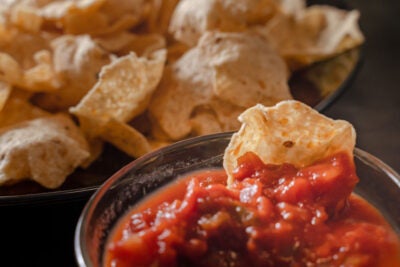Audio now makes up between 30% and 40% of any given Tostitos campaign – or more, depending on the KPI.
The brand, owned by PepsiCo’s Frito-Lay division, is making such a big bet on audio because audio works, said Hana Golden, marketing director for PepsiCo’s tortilla chip brands.
Audio can drive brand awareness and recall despite the many distractions consumers face, Golden said.
Tostitos recently implemented sonic branding and a new sonic logo into its cross-channel media campaigns and has been spending more on streaming audio channels, including sponsorship agreements with the Barstool Sports podcast “Pardon My Take.”
Party partners
Appealing to audiences through sound, including music, makes sense for Tostitos, whose products include tortilla chips and dip, both common fare at parties.
Tostitos has entered into partnerships with streaming audio platforms, including Spotify and Pandora, to distribute playlists created by its influencer and celebrity partners.
Influencer marketing and celebrity endorsements are a key component of its efforts to build a fun, party-friendly perception of the Tostitos brand, Golden said.
For example, Tostitos launched a campaign to coincide with Cinco De Mayo starring two Latin American icons, actor Danny Trejo and musician Sofia Reyes. Video spots for the campaign included Reyes’ hit song “Marte.” Tostitos also worked with TikTok influencers to promote the campaign using audio assets, like the new Tostitos sonic logo, in their videos, Golden said.
A logo you can listen to
Speaking of that sonic logo, Tostitos campaigns across video and audio channels now feature a distinct audio signature.
Tostitos worked with Made Music Studio to compose a sonic logo that combines the sounds of people enjoying the brand’s products – the crunch of a chip, a chip bag being opened, a beat drummed out on a salsa jar lid – into a musical flourish that plays over the end card in its audio and video ads.
PepsiCo first launched a company-wide sonic branding initiative with the Doritos brand in 2019, and after some promising results, the company decided to expand the initiative to its other brands, including Tostitos, Golden said.
But Tostitos is well beyond the experimentation stage at this point, Golden said.
“While we’re still in the infancy of aligning all of our comms with an audio component, it is a crucial piece of our strategy,” she said.
Audio impact
Tostitos measured the impact of its sonic logo in partnership with audio intelligence company Veritonic.
Veritonic conducted brand lift measurement panels prior to the sonic logo’s rollout in January and used that as a baseline to compare to panel results six months after the logo was added to campaign creative.
After six months in market, the sonic logo contributed to a 38% increase in brand recall and netted Tostitos a 13% higher brand favorability score compared with Veritonic’s favorability benchmarks for CPG brands.
On top of that, 17% of respondents between the ages of 18 and 34 said they felt the sonic logo embodies the Tostitos brand, and 70% of audiences across demographics found the sonic branding “fun,” which bodes well for the efforts Tostitos is making to associate its brand with the feeling of enjoying a party with friends.
Sonic branding can also help brands stand out given modern multiscreen viewing habits and people’s tendency to tune out or even leave the room during TV ad breaks, Golden said.
While sonic branding lifts brand awareness and favorability among all demographics, it is particularly effective in capturing attention from Gen Z, Golden said.
Gen Z “is the most digitally connected of all the generations that PepsiCo actively seeks to target, but they also have the shortest attention span,” she said. “Having an easily recognizable tone is a way to capture their attention, but also [foster] a subconscious connection to the feelings they might have towards our brand.”
















